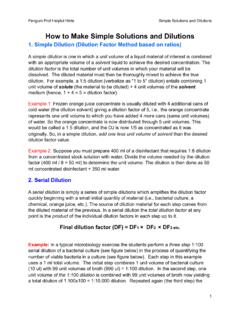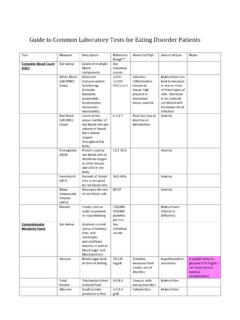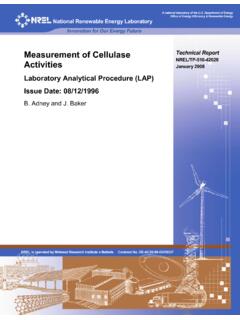Transcription of GENERAL NOTES: Lab Exercise 1: Digestion of Starch by …
1 Biol. 261!V. Pennington Digestive Enzyme Lab !Objectives 1. To describe the enzymatic Digestion of carbohydrates by salivary amylase 2. To describe the enzymatic Digestion of protein by pepsin 3. To describe the emulsification of fat by bile salts 4. To understand the enzymatic Digestion of fat by pancreatic lipase !Background Information: The digestive system breaks down food (complex polymers) into monomers through enzymatic Digestion . Only very small molecules, such as monosaccharides or amino acids can be absorbed across the gut epithelia. This lab will examine the optima for 3 important digestive enzymes . GENERAL NOTES: This lab requires a lot of work at the beginning and the end of the lab period.
2 BE ON TIME and work as a team to get ALL tubes incubating at once in order to get the best results. Use plastic tubes unless otherwise indicated. Lab Exercise 1: Digestion of Starch by Salivary Amylase The Digestion of a carbohydrate such as Starch begins in the mouth, where is it mixed with saliva containing the enzyme salivary amylase. Starch , a long chain of repeating glucose molecules, is hydrolyzed (cut) by amylase into shorter polysaccharide chains and eventually into the disaccharide maltose (known as a reducing sugar), which consists of two glucose subunits: !!!!!!!!!!!!!!!!!!!!In this experiment, you will examine the effects of pH and temperature on the activity of salivary amylase. You will measure the activity of salivary amylase by measuring the amount of product formed using Benedict s reagent, which consists of an alkaline solution of cupric ions (Cu++).
3 Cupric ions will be reduced to cuprous ions (Cu+) in the presence of maltose, forming a visible yellow-colored precipitate of cuprous oxide (Cu2O). ! 1 Biol. 261!V. Pennington Procedure: Use plastic tubes except for the one you will boil 5 clean test tubes 1 5. 2. Obtain 10 ml of saliva (use a cup and then transfer using a disposable ml transfer pipette.) Think about chocolate chip cookies if necessary. If this doesn t work, chew a piece of paraffin. ONLY 1 PERSON PROVIDES SALIVA. NO MIXING!!! ml of distilled water to tube 1. ml of saliva to tubes 2 and 3. 3 drops of concentrated HCl to tube 3. to just a boil the remaining saliva in a glass test tube by passing the tube through the flame of a Bunsen burner.
4 Use a test-tube clamp and keep the tube at an angle, pointed away from your face and from your neighbors. When it is cool, add ml of the boiled saliva to tube 4. ml of maltose to tube 5 (tube 5 is a positive control for both Starch and maltose). ml of Starch to all 5 tubes. all tubes in a 37 C water bath for at least hours. 5 new test tubes 1 5. the contents from the first set of 5 tubes in half by pouring half of the contents from each into the newly labeled tubes. one set of 5 tubes for Starch by adding a few drops of Lugol s reagent (containing iodine) to each tube. A positive result is indicated by the development of a purplish black color. Record your results. the other set of 5 tubes for the presence of maltose by adding ml of Benedict s reagent to each of the tubes and then immersing them in a rapidly boiling water bath for 2 minutes.
5 (Don t worry - the plastic tubes won t melt unless you leave them in the boiling water for 5 minutes). the tubes from the water bath and rate the result using the following scale: Blue (no maltose) - Green + Yellow ++ Orange +++ Red (most maltose) ++++ !!!!!!!! 2 Biol. 261!V. Pennington Record the results in your lab notebook: !!!!!!!!!!!!!!!!!!!!!!!Tube ContentsStarch After Incubation (Lugol s)Maltose After Incubation (Benedict s)Tube 1: Starch + distilled waterTube 2: Starch + saliva Tube 3: Starch + saliva + HClTube 4: Starch + boiled salivaTube 5: Maltose 3 Biol. 261!V. Pennington !
6 Lab Exercise 2: Digestion of Protein (Egg Albumin) By Pepsin Pepsin is an enzyme that is secreted by the chief cells in the stomach which digests proteins. In this Exercise , you will digest albumin, the major protein in egg whites. !!!!!!!!!!!!!!!!! Exercise 2 Procedure: 4 clean test tubes. Using a razor blade, cut 4 slices of egg white about the size of a fingernail and as thin as possible. It is ESSENTIAL that the slices be very thin and as uniform in size as possible. Place a slice of egg white in each of the five tubes. 1 drop of distilled water to tube 1. 2 drop of HCl to tubes 2 and 3 and 4. ml of pepsin to tubes 1, 2 and 3. ml of distilled water to tube 4. tubes 1, 2, and 4in a 37 C water bath. Place tube 3 in an ice bath or freezer. Incubate all tubes for at least hours.
7 Thaw the frozen tube after the incubation. !!!!! 4 Biol. 261!V. Pennington the appearance of the egg white in a data table in your lab notebook. !!!!!!!!!!!!!!Tube Contents / Incubation ConditionAppearance of Egg White After Incubation (describe)1: protein + pepsin, 37 C 2: protein + pepsin + HCl, 37 C 3: protein + pepsin + HCl, 0 C 4: protein + HCl, 37 C 5 Biol. 261!V. Pennington !Lab Exercise 3: Digestion of Fat (cream) by Pancreatic Juice and Bile Salts Since fat is not soluble in water, dietary fat enters the duodenum in the form of large fat droplets which must be broken down into much smaller pieces before digestive enzymes can act upon them.
8 There are two processes required for fat Digestion : !Emulsification refers to the breakdown of large droplets into smaller droplets,(just as dishwashing detergents act on grease). Bile salts are responsible for this. Digestion of fat into monoglycerides and fatty acids (accomplished by lipases, such as pancreatic lipase, which you will use today). You can measure the Digestion of fats by lipases because as the fatty acids are produced by enzymatic breakdown, the pH of the solution drops. !!!!!!!!!!!!! Exercise 3 Procedure: ml of cream to three test tubes, numbered 1-3. the following: Tube 1: add ml of water and a pinch of bile salts Tube 2: add ml of pancreatin solution Tube 3: add ml of pancreatin solution AND a pinch of bile salts the pH of all tubes and record as time 0 6 Biol.
9 261!V. Pennington the tubes at 37 C for 1 hour, checking the pH every 20 minutes, recording the data in your lab notebook. !!!!!!!!!!!!!!!!!!!!!!!!!!!!!!!!!!TimeTu be 1: Cream + Bile SaltsTube 2: Cream + PancreatinTube 3: Cream + Bile Salts + Pancreatin0 minutes 20 minutes 40 minutes 60 minutes 80 minutes 100 minutes 7 Biol. 261!V. Pennington Post-Lab Questions: !Salivary Amylase tube(s) contained the most Starch following incubation? Which tube(s) contained the most maltose? What conclusions can you draw from these results? !! you have any tubes which tested + for both Starch and maltose?
10 What does this mean? What might happen to the tube if you let it incubate for a longer period of time? !! your data, what do you think happens to salivary amylase once you swallow your saliva? Explain. ! effect does cooking have on enzyme activity? Why? !! Digestion of Albumin by Pepsin ! can you conclude about the pH optimum for pepsin? Where in the body might you find this pH? ! the effects of HCl on protein Digestion by pepsin with the effects of HCl on Starch Digestion by salivary amylase. Explain the physiological significance of these effects. ! does freezing food preserve it? !! Digestion of Fat by Pancreatic Juice and Bile Salts !1. Explain why the Digestion of fats should affect the pH of the solution. !2. What is the function of bile salts? !3. In which tube did fat Digestion occur most rapidly?









